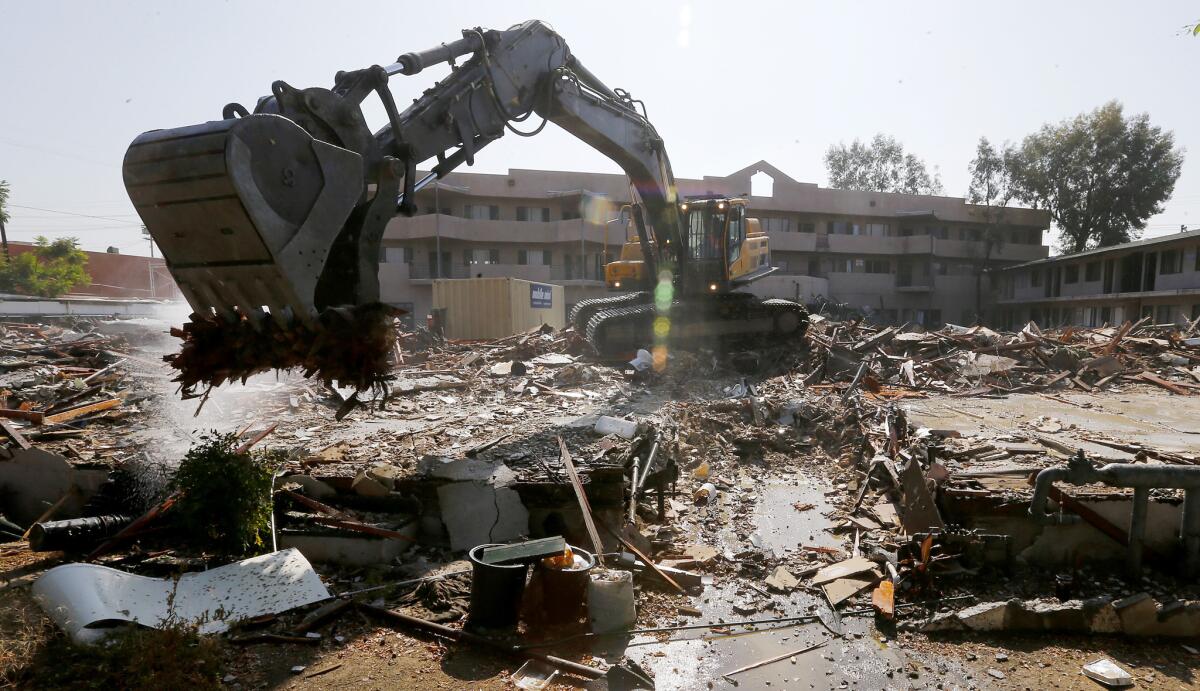After 30 years as a homeless shelter, the former Fiesta Motel in North Hollywood comes down

- Share via
In 1986, a coalition of religious leaders responded to the San Fernando Valley’s growing homeless problem by converting a motel on Lankershim Boulevard in North Hollywood into a homeless shelter.
Thirty years later, with the homeless crisis once again swelling, the former Fiesta Motel is being demolished.
But it isn’t being abandoned. Its 250 beds have been moved to a refurbished apartment building next door.
In its place, an 80,000-square-foot complex will rise, marking the evolution of two scrappy civic projects into a multimillion-dollar institution that has built hundreds of housing units and become the nerve center for all homeless services in the San Fernando and Santa Clarita valleys.
The new $40-million headquarters of L.A. Family Housing will include a health clinic, 50 units of permanent housing and a hub that will draw scattered public and private homeless services into a single location.
Along with administrative offices of L.A. Family Housing, the new center will provide space for the Los Angeles Unified School District, Neighborhood Legal Services, Los Angeles County’s health services and mental health departments and Department of Child and Family Services, Veterans Affairs, Chrysalis (job training and placement) and financial literacy nonprofits.
That will allow thousands of homeless people to access services under one roof, said Stephanie Klasky-Gamer, president and chief executive of L.A. Family Housing.
“Traveling across our 275-square-mile service region to reach multiple service agencies is a barrier to ending homelessness that has existed for far too long,” Klasky-Gamer said.
L.A. Family Housing will also be the Valley home to what is called the coordinated entry system, a centralized register of homeless people used to prioritize services to the most needy. The data system is managed by the Los Angeles Homeless Services Authority in downtown but relies on agencies around the county to do the hands-on work.
Since its incorporation in 1983, L.A. Family Housing has expanded its mission from a narrow focus on building low-income housing in the central city to a wide range of homeless services centered in the Valley, spokesman Tommy Newman said.
Its shift to the Valley began when the Valley Interfaith Council, a nonprofit formed to fight for fair housing during the 1960s, called for help.
By 1986, the council had branched into services for the elderly and then took on the burgeoning homeless crisis.
It put together $2.2 million from various sources to buy the Fiesta Motel but soon found the project short of operating funds.
Facing foreclosure, the group asked L.A. Family Housing — then known as the Los Angeles Family Housing Corp. — to take over.
“Valley Shelter represents the 30-year evolution of how we as a society have responded to homelessness,” Klasky-Gamer said. “In the 1980s it was seen as enough to offer a bed and a hot meal for up to a month, and that’s what was funded.
“In the 1990s we began to offer some services, like a health clinic, to go along with that bed. Today we know what works and breaks the cycle of homelessness: permanent housing with key supportive services.”
While beefing up the shelter, L.A. Family Housing continued building. It maintains 20 buildings, mostly in the Valley, with 396 units providing medium- and long-term housing.
In the early 2000s L.A. Family Housing began adding an outreach staff to directly engage the Valley’s homeless population. Now, it places more than 2,000 clients a year into permanent housing it doesn’t own, in addition to the 1,085 living in its buildings.
Its crisis centers accommodate 40 families and 250 individuals.
Over the last three years, new sources of funding for homeless services have increased L.A. Family Housing’s annual operating budget from $10 million to $16 million.
Twitter: @LATdoug
ALSO
3-year-old boy drowns during Fourth of July party
2 homeless men killed and 1 injured in string of attacks in San Diego
Family forced to stab retired police dog as it mauls and drags man
More to Read
Sign up for Essential California
The most important California stories and recommendations in your inbox every morning.
You may occasionally receive promotional content from the Los Angeles Times.











